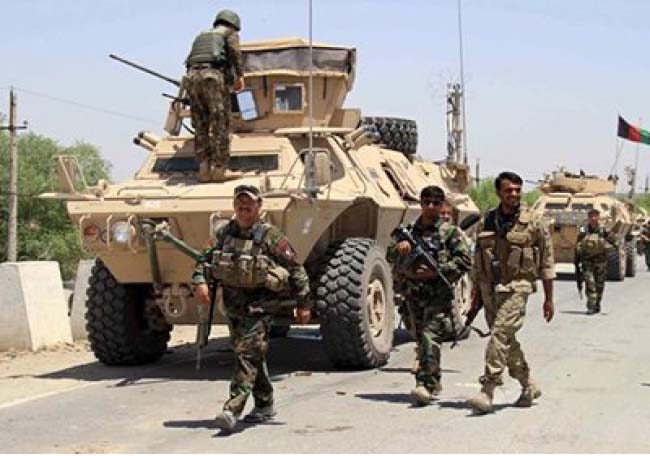Afghan National Security Forces (ANSF) are suffering a high rate of casualties in the fight against the insurgent groups. Dozens of members of the armed forces are killed, maimed or injured in the wars across the country on daily basis. The tolls are potentially undermining the anti-insurgency campaign of the Afghan government as it is struggling to prevent the increasing attrition of the army and police forces. One of the key factors behind the aggressiveness of the insurgents’ offensives and the high casualties of the armed forces is the flawed management of the war efforts by the government. In an open letter to President Ashraf Ghani, Deputy Governor of Helmand province, Mohammad Jan Rasulyar, posted on Facebook asking for help from the central government in the fight against the insurgents in the province. According to Helmand’s deputy governor, ninety Afghan soldiers have been killed during last two days in fighting with the Taliban militants in the province. The media reports say, heavy clashes have been going on between the Taliban and security forces in Sangin and Gereshk districts of Helmand Province in past two days.
The clashes in Helmand province and the open plea for help by Helmand local officials once again highlight the mismanagement of the armed forces fighting the Taliban on the battlefields and the disconnection among army and police units stationed on duties and the central headquarters. It has become a norm now that the central government sends reinforcements after local units are overpowered by the Taliban after hours and even days of fighting in far remote areas across the country. Dozens of members of the army and police were killed in the past while fighting the Taliban in isolated districts after being left with no reinforcements or aerial support from the central headquarters. The incidents in Badakhshan and Kunar provinces and the incident in Jalriz district left the flaws in the war management bare to the public. The gruesome deaths of the security forces happen when the army units were not backed with reinforcements or received it very late.
Given the failure of the central headquarters of the army and police forces in sending reinforcements to conflict areas in time, the Afghan defense and security establishments suffer systematic flaws. The deputy governor of Helmand province warned of the danger of some districts falling to the Taliban. He criticized lack of support from the central government, calling on the president to take necessary measures for sending reinforcements in the province. There are widespread errors, negligent behaviors and shortcomings in the war management that causes casualties for the soldiers and districts falling to the Taliban. It is believed that the Afghan army largely suffers a lack of coordination among army units on duties. Due to the inefficient chain of command, local government and security officials resort to conveying their messages to the high-ranking authorities through mass media and social networking websites. This rare approach indicates the systematic bottlenecks in the government report and command chains.
The existing systematic flaws in the leadership of the security sector result to high rate of casualties among the armed forces, endangering the future of the force profoundly. According to the reports, an employee of the hospital in Sangin district of Helmand province has told the media that bodies of more than a hundred security officers and seventeen civilians were transferred to the hospital. There is an urgent need for the government to review and amend the flaws existing in the chain of command of the armed forces including the police and army forces.
There is a long path ahead for ANSF to overcome the current security threats in the country and win the war against the insurgency. The ongoing war in Afghanistan is not expected to end in the near future and will probably last for another decade or more. The government needs to take a two-tier approach of peace and war against the militant groups. To win the anti-insurgency campaign militarily, the Afghan government needs to redefine the current war efforts in the country as a war of erosion. The current democratic system needs to be resistant not to erode with the ongoing war but to exert pressures on the militants and lead them into a final erosion and disintegration. Such an approach will help the government to pursue a long-term campaign against the militant groups. The redefined military approach should focus on gradually weakening the insurgent groups rather than eliminating the militants over a night.
Many areas are now under the control of the Taliban and other insurgent groups. According to reports, Baghran and Washir districts of Helmand and many other areas in Ghazni, Kunduz are under Taliban control. The groups are also actively fighting in many other districts of the province. The government should take the war to the territories where the insurgent groups are controlling grounds. However, it would be very crucial for ANSF to focus on how to avoid casualties. A poorly organized fighting against the militant groups would not lead the ANSF to success.
On the other hand, the government needs to enhance the management of the war efforts. There should be better communication and coordination among army units stationed on the field as well as between the local units and the central headquarters. In addition to the coordination and management of the war efforts, the government needs to do more to convince the international community to provide more advanced weaponry and technical assistance to ANSF. This would help to better handle the war efforts and effectively communicate and coordinate among army units and the authorities, which in turn, would help effectiveness of the fight against the militants and result to decrease of the casualties of the security forces.

